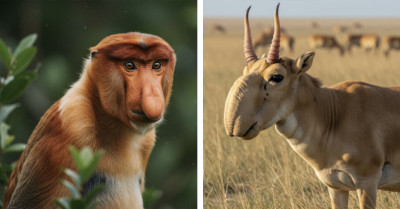14 Fierce Female Leaders Of The Animal Kingdom You Need To Know
While humans are still working toward gender equality, many animal species already have powerful females in charge. It might surprise you, but the natural world has plenty of girl bosses leading the way. Today, we’re celebrating these fierce females and their incredible leadership roles.
From majestic elephants to industrious ants, female animals make crucial decisions, care for their young, and look absolutely adorable while doing it. For instance, did you know that in hyena clans, the top female makes all the important decisions?
She leads the pack with authority and ensures the well-being of her family. In bonobo groups, females form strong alliances and often control the social dynamics, creating a cooperative and peaceful environment.
Elephant herds are guided by a wise matriarch who ensures the safety and survival of the group by remembering crucial locations for water and food, especially during dry seasons. Even the smallest creatures, like ants, have female queens who efficiently manage their colonies, overseeing all activities and ensuring the survival of their brood.
These examples highlight the prevalence and importance of female leadership in the animal kingdom. From the skies to the savannas, these girl bosses are running the show. So, let’s delve into these fascinating stories and admire some beautiful pictures of these wild leaders.
1. African and Asian Elephants

2. Elephant herds are typically led by the oldest female, known as the matriarch, who holds a pivotal role within the group.

3. As the most experienced member, the matriarch is responsible for making critical decisions about the herd's movements, ensuring they find food, water, and safe resting places.

Female Leadership in the Animal Kingdom
Dr. Jane Goodall, a renowned primatologist, emphasizes that female leadership in animal societies often mirrors strategies that can inspire human leadership. Her studies reveal that female elephants, for example, lead their herds with remarkable empathy and wisdom, showing how nurturing traits can be powerful in leadership roles.
Goodall states, “It is the wise matriarchs that guide their family units, showcasing the strength in collaboration and community.” This highlights the importance of emotional intelligence in leadership, a lesson applicable to both humans and animals.
To enhance leadership skills, aspiring leaders can learn much from these fierce female animals. One practical approach is to engage in active listening and empathy, which are crucial traits displayed by female leaders in the animal kingdom. Dr. Brené Brown, a leadership expert, emphasizes that vulnerability and connection are key to effective leadership.
She suggests, “Practicing empathy and building genuine relationships can transform your leadership style.” Implementing these traits can foster a more inclusive and collaborative environment, whether in the workplace or community settings.
4. Her knowledge of the environment, passed down through generations, is essential for the survival of the herd, especially in harsh conditions.

5. Wolves
Wolf packs typically have an alpha pair, consisting of a male and female, leading the group. However, in some packs, the female often takes on a more dominant role, particularly when it comes to decision-making and caring for the pups.

6. Bonobos

In examining the matriarchal structures of elephant herds, researchers like Dr. Cynthia Moss emphasize that these female leaders play critical roles in decision-making. They determine travel routes, locate water sources, and protect their young from predators, showcasing innate leadership skills driven by necessity.
Dr. Moss suggests that understanding these dynamics can enhance our approaches to leadership in human contexts, particularly in nurturing environments. She notes, “Leadership is not just about authority; it’s about understanding and adapting to the group's needs.”
7. Bonobos are a matriarchal species, meaning social structures and leadership within their groups are predominantly governed by females.
This unique structure fosters a more peaceful and cooperative society, where conflicts are often resolved through social bonding activities, such as grooming and play.

8. Female bonobos form strong alliances and networks, often using these relationships to influence group decisions and maintain harmony within the troop.

9. Spotted Hyenas

Hyena Hierarchies and Social Dynamics
Hyenas provide a fascinating case study in female-led social structures. Dr. Kay Holekamp, a leading researcher in hyena behavior, reveals that in many species, including hyenas, females often outrank males and exhibit dominant behaviors. This dominance is linked to their role in nurturing and protecting the clan.
Dr. Holekamp explains, “The social structure of hyenas reveals a complex hierarchy where females not only lead but also cooperate in raising young, which is a vital aspect of survival.” This insight can serve as a model for understanding collaborative leadership in other species.
10. Orcas

11. Meerkats

12. Meerkats live in highly social groups known as mobs or clans, where they exhibit cooperative behaviors such as sharing food, grooming each other, and taking turns acting as sentinels to watch for predators.

Experts in animal behavior, such as Dr. Frans de Waal, highlight that female animals often employ social intelligence to navigate their environments. For instance, female chimpanzees are known to use alliances to gain and maintain social status within their groups.
Dr. de Waal emphasizes, “The ability to form strong social bonds is crucial for success in both animal and human societies.” He advises that fostering relationships and collaboration can lead to more effective leadership strategies in professional settings.
13. Ring-Tailed Lemurs

14. Female ring-tailed lemurs assert their leadership through grooming, social bonding, and aggressive behaviors, ensuring their group's hierarchy and stability.

15. The females make crucial decisions about foraging routes and resting locations, guiding the group's daily activities and overall survival strategies.

Lessons from Ant Colonies
Ant colonies are another remarkable example of female leadership. Female worker ants are responsible for foraging, nursing, and defending the colony, showcasing their multifaceted roles. Dr. Deborah Gordon, an expert in ant behavior, notes that these tasks require sophisticated decision-making and teamwork.
She explains that understanding ant societies can improve our organizational strategies. “By observing how ants allocate tasks based on individual strengths, teams can enhance their efficiency and productivity,” Dr. Gordon suggests. This highlights the importance of recognizing diverse skill sets in any leadership context.
16. Lions

17. These lionesses work together to hunt, raise their cubs, and defend their territory, ensuring the pride's cohesion and survival.

18. Honeybees

Female wolves also exhibit strong leadership qualities within their packs. According to Dr. L. David Mech, a wolf expert, the alpha female plays a crucial role in the pack's social structure and survival. Her ability to lead hunts and nurture pups is essential for the pack's success.
Dr. Mech points out that “the alpha female's leadership is based on both strength and nurturing, illustrating the importance of balance in effective leadership.” This reinforces the idea that leadership can be both assertive and compassionate, a lesson relevant to human interactions.
19. Ants

20. Ant colonies are female-led, with a single queen at the top who is responsible for laying all the eggs, while female worker ants handle foraging, nest maintenance, and caring for the young, ensuring the colony's survival and efficiency.

21. Mongoose

Conservation and Female Leadership
Conservation efforts have increasingly recognized the vital role of women in leadership positions. Dr. Wangari Maathai, founder of the Green Belt Movement, advocated for environmental conservation led by women, emphasizing their unique perspectives and experiences.
Maathai states, “Women are often the primary managers of natural resources, and empowering them leads to sustainable practices.” This insight suggests that when women are given leadership roles in environmental management, the outcomes can be profoundly positive, reinforcing the need for gender equity in conservation efforts.
22. In mongoose packs, particularly in species like the banded mongoose, social groups are often led by dominant females who make key decisions about the group's movements, foraging activities, and territory defense, ensuring the well-being and organization of the pack.

23. Macaws

So next time you think only humans strive for equality, remember these fierce female leaders in the animal kingdom. They prove that girl power isn't just a human thing—it's a wild one! Who runs the world?
Clearly, it's the ladies, paws down. Keep exploring and stay wild!
Comment down your thoughts, or share this article for all your family and friends to see!
Celebrating the fierce female leaders of the animal kingdom not only highlights their critical roles in their ecosystems but also offers valuable insights for human leadership. From elephants to hyenas and ants, these animals exemplify how effective leadership often involves empathy, collaboration, and adaptability.
By integrating these lessons into our own leadership practices, we can create more inclusive and effective environments. As we recognize the importance of female leadership across species, we can also strive for greater gender equality and empowerment in our own communities.



